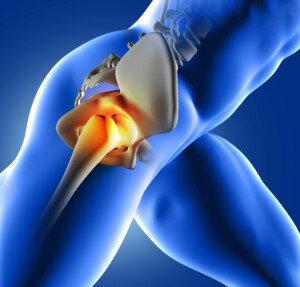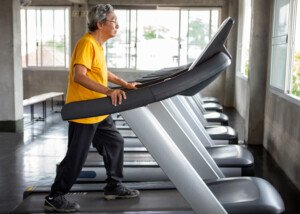Does your hip hurt ONLY when you walk on a treadmill?
Perhaps this starts up soon after getting on the machine, and perhaps it goes away pretty soon after you get off?
Oddly, your hip is just fine when you’re walking around your house, inside buildings and outside for exercise.
So it’s easy to narrow down the source of your hip pain: using a treadmill.
You’re probably supposing that the treadmill causes hip discomfort because it’s an “unnatural” way to walk.
If you want to get really picky about what constitutes natural vs. unnatural walking, we can say that walking outside on asphalt is very unnatural – since asphalt is a product of modern industrialization rather than natural earth.
The TRUE Cause of Your Hip Pain when Walking on a Treadmill
I’m betting that you HOLD ON when you’re walking. Maybe it’s the bar in front. Or perhaps it’s the rails on the side. Or maybe you plaster your hands on top of the console.
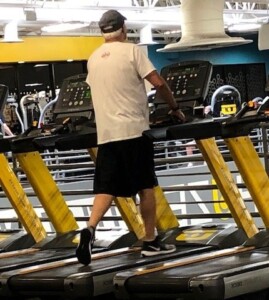
I’m also betting that you set the speed to at least 3.5 mph. But even if you use a slower speed, there’s a very logical explanation for why holding onto the treadmill is why you’re having problems.
When we walk without clinging onto anything for support, our hips move in natural synch with our upper body.
“The alternative reciprocal mechanism of walking — one arm goes forward along with the opposite leg — is important for neurological health,” says Dr. Eugene Charles, DC, Diplomate of applied kinesiology and author of “Journey to Healing: The Art and Science of Applied Kinesiology.”
“Holding on the front bars limits this natural motion and causes a restriction in the ribcage and thoracic spine, and can cause these intercostal joints (where the ribs connect to the spine in the midback) to become locked up.
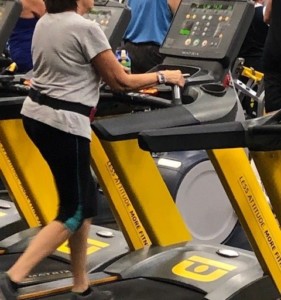
“This can affect the breathing mechanism and appears to disrupt the natural neural impulses that should occur from the free and natural movement of the arms, shoulders and ribcage.”
In short, holding onto the treadmill – anywhere, not just the front bar – causes the hips to over-rotate because the upper body is locked up.
This over-rotation will become more pronounced, more ballistic, the faster the speed.
The tendency is to grip the treadmill tighter when the speed gets faster. This accentuates the upper-body lockup, and hence, increases the ballistic rotation of the hips.

Is it any wonder, then, that eventually one will develop a painful repetitive stress injury of at least one hip?
It’s easy to understand why the hip pain disappears once you get off the treadmill, returning to a natural gait pattern when walking from point A to point B.
Why do you hold onto the treadmill in the first place?
When I was a personal trainer, I’d always ask people at the gym this question. The most popular responses were:
• “I’ll fall off if I let go.”
• “Everyone else does it so I thought that’s what you should do.”
• “I thought that’s what you should do because the rails are there.”
The second trier of responses were:
• “My trainer told me it’s okay to hold on.” Interestingly, this answer never came from a man. Trainers should empower, not enable, their female clients.
• “I get dizzy if I let go.”
• “I didn’t think it made a difference.”
I had clients with varying physical or medical issues walking on the treadmill WITHOUT holding on.
This included elderly people, morbidly obese people, those with osteoarthritis, one with Meniere’s disease, and self-proclaimed klutzes who were just plain afraid of letting go (but soon changed their mind after just a few minutes of walking hands-free with its naturally-occurring good posture).
How to Make the Hip Pain Go Away
Let go of the treadmill. For those of you who believe you’ll fall off, then for Pete’s sake, reduce the speed.
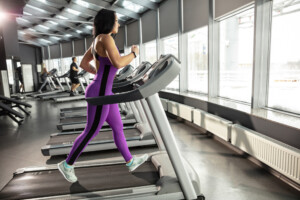
Freepik.com/master1305
It’s no coincidence that nearly every person who ever told me they were afraid of toppling off, had the speed at least 3.5 mph, even 4 mph! And often with a high incline!
Those who reported that letting go made them dizzy soon acclimated to hands-free walking, and the dizziness went away.
I bet anything that if the only time you get hip pain is when you’re walking on a treadmill, that it will outright vanish once you start walking naturally: hands OFF, upper body moving in synch with your lower body; hips moving the way they’re supposed to move when you walk.
Start at slower speeds and gradually increase the speed. If you feel you need to hold on, then guess what: You’re going too fast and/or the incline is too high.
Solution: Adjust the settings to something realistic, not something suitable for a competitive racewalker or mountaineer.
Dr. Charles has helped thousands of patients and taught over 1,200 doctors during his 30+ years of practice. He has also created the Power Kinetics® Exercise Program and line of nutritional vitamins and performance supplements. amazon.com/Journey-Healing-Science-Applied-Kinesiology/dp/0964421763
 Lorra Garrick is a former personal trainer certified by the American Council on Exercise. At Bally Total Fitness she trained clients of all ages for fat loss, muscle building, fitness and improved health.
Lorra Garrick is a former personal trainer certified by the American Council on Exercise. At Bally Total Fitness she trained clients of all ages for fat loss, muscle building, fitness and improved health.
.

